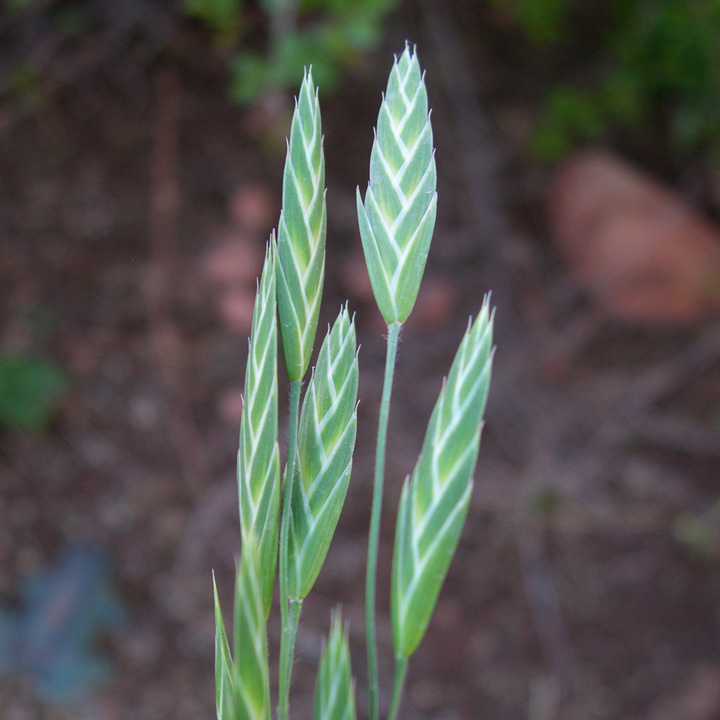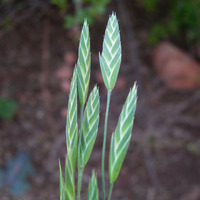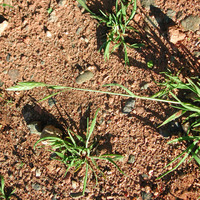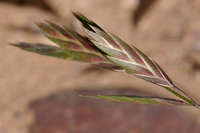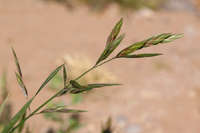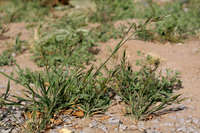Annuals, Terrestrial, not aquatic, Stems nodes swollen or brittle, Stems erect or ascending, Stems caespitose, tufted, or clustered, Stems terete, round in cross section, or polygonal, Stem internodes hollow, Stems with inflorescence less than 1 m tall, Stems, culms, or scapes exceeding basal leaves, Leaves mostly cauline, Leaves conspicuously 2-ranked, distichous, Leaves sheathing at base, Leaf sheath mostly closed, Leaf sheath smooth, glabrous, Leaf sheath hairy, hispid or prickly, Leaf sheath and blade differentiated, Leaf blades linear, Leaf blades 2-10 mm wide, Leaf blades mostly flat, Leaf blades mostly glabrous, Ligule present, Ligule an unfringed eciliate membrane, Inflorescence terminal, Inflorescence an open panicle, openly paniculate, branches spreading, Inflorescence solitary, with 1 spike, fascicle, glomerule, head, or cluster per stem or culm, Inflorescence lax, widely spreading, branches drooping, pendulous, Inflorescence with 2-10 branches, Inflorescence branches more than 10 to numerous, Flowers bisexual, Spikelets pedicellate, Spikelets laterally compressed, Spikelet 3-10 mm wide, Spikelets with 3-7 florets, Spikelets with 8-40 florets, Spikelets solitary at rachis nodes, Spikelets all alike and fertille, Spikelets bisexual, Spikelets dis articulating above the glumes, glumes persistent, Spikelets disarticulating beneath or between the florets, Rachilla or pedicel glabrous, Glumes present, empty bracts, Glumes 2 clearly present, Glumes equal or subequal, Glumes distinctly unequal, Glumes shorter than adjacent lemma, Glumes keeled or winged, Glumes 4-7 nerved, Glumes 8-15 nerved, Lemmas thin, chartaceous, hyaline, cartilaginous, or membranous, Lemma glabrous, Lemma apex dentate, 2-fid, Lemma awnless, Lemma mucronate, very shortly beaked or awned, less than 1-2 mm, Lemma with 1 awn, Lemma awn less than 1 cm long, Lemma awn subapical or dorsal, Lemma awns straight or curved to base, Lemma margins thin, lying flat, Lemma straight, Palea present, well developed, Palea membranous, hyaline, Palea shorter than lemma, Palea keels winged, scabrous, or ciliate, Stamens 3, Styles 2-fid, deeply 2-branched, Stigmas 2, Fruit - caryopsis, Caryopsis ellipsoid, longitudinally grooved, hilum long-linear, Caryopsis hairy at apex .
Common Name: rescuegrass
Duration: Annual
Nativity: Non-Native
Lifeform: Graminoid
General: Winter annual or biennial grass with erect to spreading stems 30-120 cm tall.
Vegetative: Sheaths retrorsley soft pubescent, the hairs sometimes confined to the throat; ligules long, up to 5 mm, glabrous to pilose, irregularly toothed; auricles small; blades flat, thin, 4-30 cm long, 4-8 mm broad, usually glabrous.
Inflorescence: Contracted or open panicle, erect or nodding, 9-28 cm; spikelets large, mostly 2-4 cm long and with 5-12 florets, strongly laterally compressed; first glume 3-5 nerved, second glume 7-9 nerved; lemma strongly compressed laterally, 1-2 cm long, glabrous or scabrous, often with a hyaline margin, with 9-13 raised and riblike veins, awnless or with an awn shorter than 4 mm.
Ecology: Found mainly as a weed in laws, gardens, roadsides from 4,000-7,000 ft (1219-2134 m); flowers February-June.
Distribution: Thought to be native to S. Amer; introduced to much of N. Amer. except the NW, midwest and e CAN; south through MEX; Europe, Africa, Australia and Asia.
Notes: A variable plant in height and growth form with leaves mostly in a basal tuft. Distinguished from other bromes by the strongly flattened spikelets and lack of awns. FNA recognizes 2 varieties: material from the southwest belongs to var. catharicus, which is awnless or has short awns up to 3.5 mm; var. elatus is found in central California and has awns up to 1 cm.
Ethnobotany: Seeds parched, ground into flour and used to make bread and mush; also used as fodder for livestock.
Etymology: Bromus is from Greek bromo, for stinking; catharticus is from Greek katharos, pure, or kathartes, a purifier, cleanser.
Synonyms: Bromus brevis, B. haenkeanus, B. unioloides, B. willdenowii, Ceratochloa cathartica, C. unioloides, C. willdenowii, Festuca unioloides
Editor: SBuckley 2010, FSCoburn 2015
Stout annual or short-lived perennial to 1 m; blades flat and broad, 3-12 mm wide; ligule 2.5-5 mm; panicles 10-30 cm, loosely contracted; spikelets (16-)20-30(-35) mm, 4-12-fld, strongly compressed; glumes lanceolate, acuminate, strongly keeled, the first 8-11.5 mm, 3-veined, the second 9-13 mm, 5-veined; lemmas 12-20 mm, keeled, closely overlapping, glabrous (at least below) between the 11-13 long-ciliate veins; awns to 2.5 mm, or none; palea half as long as the lemma; 2n=28, 42, 56. Native of S. Amer., widely cult. for forage in warm regions, and occasionally intr. or escaped in the s. part of our range, n. to N.Y. and Mo. (B. unioloides; B. willdenowii)
Gleason, Henry A. & Cronquist, Arthur J. 1991. Manual of vascular plants of northeastern United States and adjacent Canada. lxxv + 910 pp.
©The New York Botanical Garden. All rights reserved. Used by permission.


